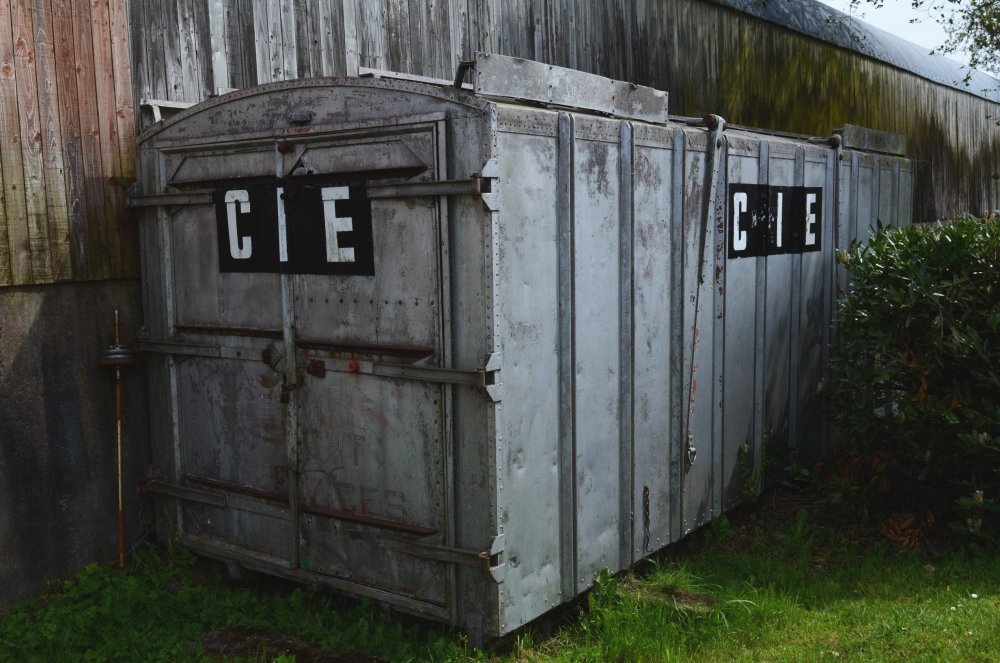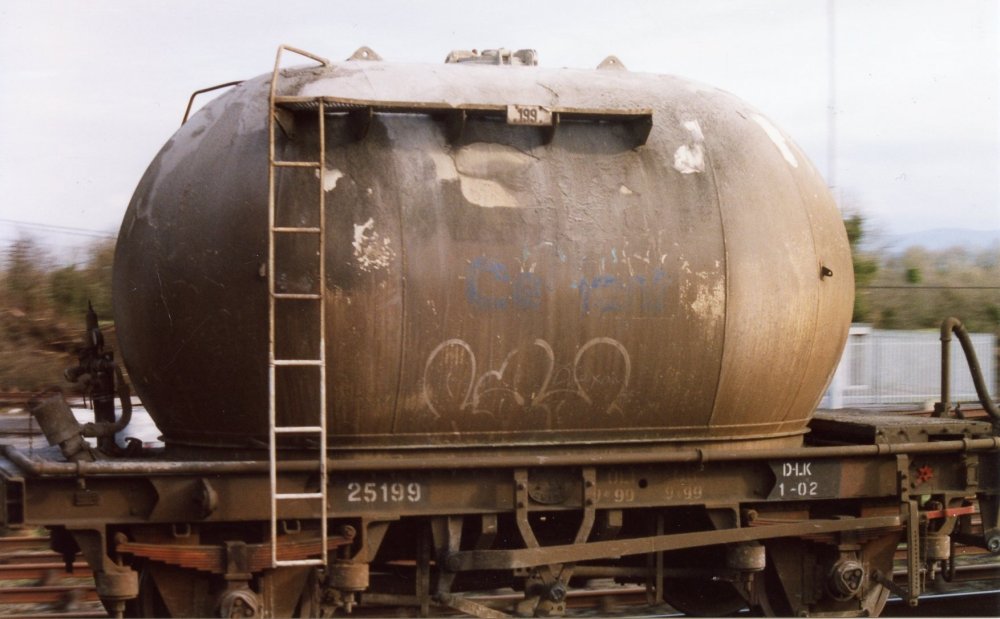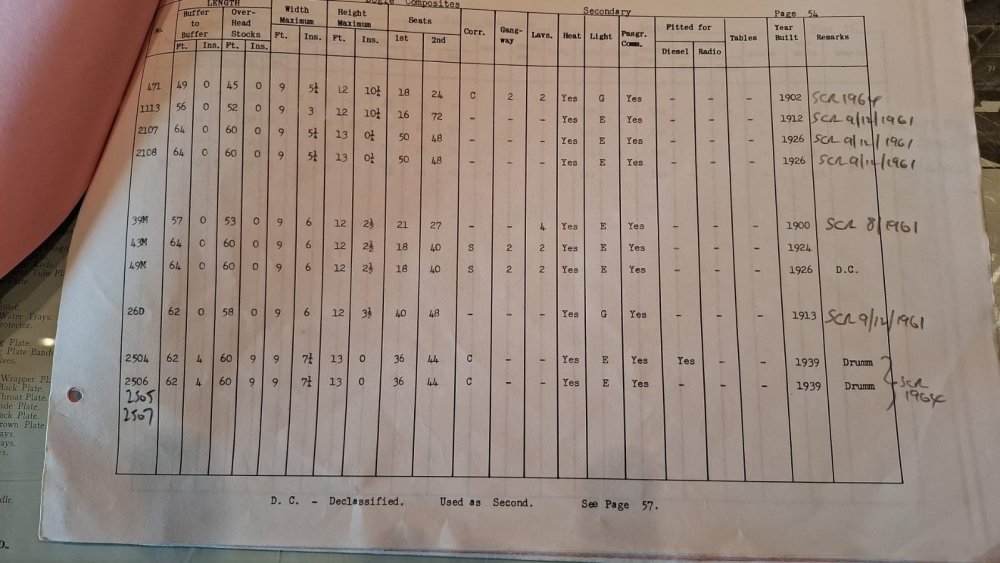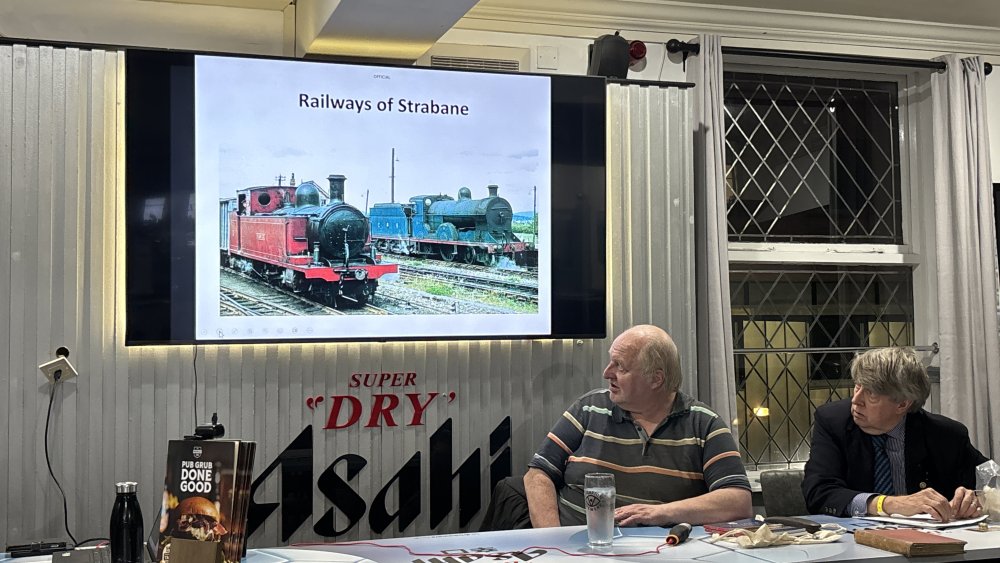
Mol_PMB
Members-
Posts
2,280 -
Joined
-
Last visited
-
Days Won
125
Content Type
Profiles
Forums
Events
Gallery
Everything posted by Mol_PMB
-
It's plane that this thread is starting to runway off topic.
-
The GSWR carriage diagrams book (Transport Research Associates) contains a list of the GSWR carriages which were renumbered in the A series, with numbers before and after. Obviously that only covers the GSWR vehicles, but I have incorporated data from this list into my spreadsheet. I agree there is confusion about withdrawal / scrapping dates, and I doubt I'll be able to resolve this completely. Many publications consider them to be equivalent, but there are plenty of examples where a coach was withdrawn from public service but then repurposed as an engineers' vehicle, being scrapped much later or not at all. The RPSI's 12-wheeler 861 is another example. The IRRS journals can be useful for contemporary reports of vehicles consigned to Sallins or Mullingar, but even then some vehicles escaped and in some cases the next issue of the journal has a note that a carriage is back in service after it had been reported as withdrawn. My spreadsheet is never going to be perfect - there are inconsistencies in the source data, and CIE itself was inconsistent in the way they classified and renumbered some vehicles. Plus there are opportunities for errors to creep in at every stage. But I hope it will be useful and I've certainly learnt a lot in compiling it. Another two questions for the carriage experts. 1. The small group of carriages that CIE built themselves in the early 1960s, almost alongside the Cravens, were: Firsts 1145-1146 Standards 1497-1503 Composites 2172-2179 Catering cars 2402-2403 Like the laminates that preceded them in the mid-late 1950s, these early 1960s coaches had triangulated underframes and commonwealth bogies, but their body profile had vertical sides. So my question relates to the body construction of these early 1960s coaches. Were they: True 'laminate' (i.e. laminated wood hoop and rib structure with aluminium-faced ply skin) Traditional wood-framed, steel-skinned construction as used in the early 1950s? Or some combination of the two? 2. What metal was used for the body structure and skin of the Park Royals? Steel Aluminium
-
Just a quick update. I am not far off completing my first draft of the combined CIE carriage register spreadsheet which I will upload here in the next few days. The scope I have set myself is to include all steam-heated, vacuum-braked carriages in service with CIE from 1961 until the final withdrawal of the Cravens in 2006. It's been a lot of work to collate and cross-reference data from about 50 different sources including two editions of the CIE carriage register and many entries in journals and books. Some entries are simple, some are complicated where carriages were rebuilt, renumbered and reclassified several times during their life. Already I have ideas of how to improve it, such as adding hyperlinks to connect the entries where vehicles have been rebuilt/renumbered, and links or references to published photos of each carriage. That will take even longer, so I'm planning to publish the simple version in the meantime. An area I am presently weak on is the carriages inherited from the GNR, and to a lesser extent the MGWR and the DSER. The listing would definitely benefit from the knowledge of a GNR carriage expert. I hope this will prove a useful reference. Cheers, Paul
-
Is there anyone on the forum who lives close to Dromod? Or knows the people at the C&L museum there? We would really like to confirm a couple of dimensions on this container, to ensure that the 3D printed model ends up the right size. At the moment we're not sure the proportions are quite right. I'd be happy to make a donation to the C&L museum in return for 4 basic measurements. Cheers, Paul
-
Many thanks. That looks very good for the British Railways containers, which were common in Ireland. Some of the CIE ones were similar, others were rather different. I haven't yet found anyone with a copy of a CIE container diagram book that is old enough to show their pre-ISO containers. That may be because many of them were owned by the road freight division of CIE, rather than the railway. I think we can infer the dimensions of the traditional wooden types from the BR diagrams. The 1960s alloy containers were definitely bigger. Happily my plea for a diagram of the 25201 series flat wagon also produced an excellent result.
-
The latest IRRS Flickr upload includes some images of the later bubbles under construction at Inchicore. Here are the tanks, you can just see that there are stencilled and chalked markings on them: https://www.flickr.com/photos/irishrailwayarchive/54778606819 https://www.flickr.com/photos/irishrailwayarchive/54778614773 Not so obvious, but I think there is a row of tankless bubble underframes to the left of the D class here: https://www.flickr.com/photos/irishrailwayarchive/54777521647 https://www.flickr.com/photos/irishrailwayarchive/54777524317 From an earlier IRRS upload and the penultimate batch of bubbles, here's 25129 with the tank and underframe assembled, but not yet fully painted: https://www.flickr.com/photos/irishrailwayarchive/53570447106 Note the shipping instructions including 'Dublin' stencilled on the side of the tank, and 'Sanguity' chalked on. She was in the Everard fleet:
-
Definitely an odd one. It looks more like a shunt dolly, elevated for better visibility. Note also the track circuit diamond on the post. Would be interesting to work out where exactly this was, and what move this signal was for. Could it be signal 13 on this diagram? https://www.flickr.com/photos/irishrailwayarchive/49761789231
-
I've put some money in the pot too - these wagons are central to my memories of Irish railways. Just out of interest, which wagon number is it?
-
Frustrating indeed. I normally build my own boards but to give me a running start for my mini Irish layout I have ordered some laser-cut baseboard kits. Hopefully they will arrive complete, but there’s still the lead time of 6+ weeks to deal with. I hope your missing parts arrive soon as I’m looking forward to seeing this develop.
-
The Loch is quite unusual for a 4-4-0 in being outside cylinder, not many of those in Ireland except much bigger blue locos. Though I suppose you wouldn’t have to use the cylinders and connecting rods. The D40 has proportions and shape visually similar to MGWR A class (original) but I haven’t checked the dimensions. There may be some options to convert to 2-4-0 tender loco types too? But as noted above they are relatively expensive as a donor chassis and very tricky to regauge if required.
-
Some work is under way to produce a 3D printable version of the CIE alloy container of 1961/62, like the surviving example at Dromod: It is being developed by the same team who did these; I have provided prototype photos, dimensions etc: https://www.rmweb.co.uk/forums/topic/182716-big-4-pre-nationalization-container-diagrams/?do=findComment&comment=5345870 I will update this thread when more information is available. These containers are too long for traditional unfitted flat or open wagons, and need to ride on 25201 or 25436 series flat wagons. The 25436 series are quite well-known but the 25201 series less so - some photos and details here: https://irishrailwaymodeller.com/topic/17496-cie-ballast-wagons-late-1960s-to-1980s-not-hoppers-or-flats/#findComment-250654 It's a long shot, but does anyone have a diagram or drawing for the 25201 series flats? If not, I can probably work it out well enough from photos and known dimensions. Also, does anyone have any diagrams of CIE containers of this pre-ISO era? The 1965-built side door type shown in this RPSI photo would be of particular interest: Many thanks, Paul
-
That's looking great. It's a tight fit in the room - but good use of space as long as you can still get to those shelves somehow! I look forward to seeing this develop.
-
Some progress on painting and lettering the IRCH vans. These are intended to represent the period around 1960. The one lettered GN will have CIE stencils applied as well, but after I have done a bit of weathering so that they look fresher than the original lettering. All these have been lettered with a complete mish-mash of decals from different sources, but hopefully a bit of weathering will make them look a bit more consistent! Before anyone says I can't put a snail on a red-brown van, I have seen photos showing both 4166N and 2057N in this scheme in the early 1960s. Perhaps they were overhauled at Dundalk and came out in GN colours with CIE logos?
- 41 replies
-
- 12
-

-

-
Well, happily, you can now be sure they did. The photos linked above show both the later sets in the simpler green livery with a single waist line with '2' class digits on the doors, no snails. Some of the images are in colour, and they are parked next to an older coach in the older darker green livery with complex lining. You need to be an IRRS member to see their Flickr archive of nearly 30,000 Irish railway photos - highly recommended. Wonderful - that is very clear and detailed, resolves my questions and confirms the repaint in simpler livery. I shall update my carriage register spreadsheet accordingly.
-
Many thanks for the extra information. There are some photos of the Drumm cars in later life on the IRRS Flickr: Older sets: https://www.flickr.com/photos/irishrailwayarchive/54253405400/ https://www.flickr.com/photos/irishrailwayarchive/54251301406/ Later sets: https://www.flickr.com/photos/irishrailwayarchive/53509040104/ https://www.flickr.com/photos/irishrailwayarchive/53509080753/ https://www.flickr.com/photos/irishrailwayarchive/53454365270/ https://www.flickr.com/photos/irishrailwayarchive/54250396627/ https://www.flickr.com/photos/irishrailwayarchive/53507224975/ https://www.flickr.com/photos/irishrailwayarchive/53570664018/ Note that these received two iterations of CIE livery, the original 1940s scheme and the simpler late 1950s scheme. Originally the sets were lettered but the individual vehicles seem to have also carried numbers in the 250x series - some are legible in these photos, even when in GSR livery as here: http://www.industrialheritageireland.info/BookReviews/Covers/Railway/The Story of the Drumm Battery Train.jpg It looks like sets A and B were 2500-2503, and sets C and D were 2504-2507. But they may not have been in order - based on the photos 2504 seems to have been in set D. The later sets were classified as secondary stock in the 1961 carriage register and are shown at the bottom of this page. I assume the articulated pairs were 2504-2505 and 2506-2507. Note that one of them is listed as being through-wired for AEC railcar operation, which would be plausible as these were used as suburban hauled stock at the time. Also several photos of 386: https://www.flickr.com/photos/irishrailwayarchive/53509041219/ https://www.flickr.com/photos/irishrailwayarchive/53507833502/ https://www.flickr.com/photos/irishrailwayarchive/53511681460/ https://www.flickr.com/photos/irishrailwayarchive/53508678098/
-
Many thanks, very interesting. Is there any info on the numbering of the sets in later life, or of their period of usage as hauled stock? I’m trying to reconcile the vehicles listed in the 250x series in the 1961 carriage register with the original set letters.
-
I imagine this one will take advantage of advances in model technology and detail since the Bachmann model was produced, and will have finer detail and more variants, plus more gadgets like sound and firebox glow. Bit it’s likely that many of those finer details will be incorrect for the Irish variant, and gadgets don’t appeal to everyone. Neither will be easy to convert to 21mm gauge. So, pros and cons. You might find some cheap Bachmann ones on the secondhand market as a consequence?
-
It’s remarkable how many new products they have announced recently, especially with rather niche locos.
-
Many thanks John, that’s very helpful.
-
Super attention to detail. Add a couple of firsts and a gen van and you have the Wexford Opera Train!
-
An excellent talk this evening by @airfixfan of this parish - many thanks! Two for the price of one really - a fascinating review of the effect of partition on all the cross-border lines and communities, followed by a focus on Strabane. Thanks again! The IRRS has branches in Manchester and Cork as well as the better-known Dublin and London centres. Talks are available online too. See the IRRS website for details of the local programmes.
-
It's taken me a while to get these physically complete, but I've finally achieved it this afternoon. With a brief sunny spell between the torrential storms, I was able to get a few photos. Trio: GNR vac-fitted: GNR unfitted, sides overlaid with sheeting: MGWR convertible (tarpaulin will be added after painting): They are now having a good wash and dry, and will then move on to the paintshop stage. But that's for another day - I might see one or two of you in the Waldorf this evening?
- 41 replies
-
- 10
-

-
Rapido seem to be having a splurge of new annoucements recently, including several classes of pre-grouping 4-4-0 locos: https://rapidotrains.co.uk/product-category/uk/oo-gauge/oo-locomotives/lner-d40/ https://rapidotrains.co.uk/product-category/uk/oo-gauge/oo-locomotives/secr-g-class/ https://rapidotrains.co.uk/product-category/uk/oo-gauge/oo-locomotives/hr-loch-class/ https://rapidotrains.co.uk/product-category/uk/oo-gauge/oo-locomotives/mr-483/ Whist not directly relevant to Irish modelling, some of these might be useful conversion fodder, or provide good chassis for 3D-printed Irish bodies. At a push some could be repainted in Irish livery and be 'close enough'. The most recent announcement (the GNoSR / SECR type) has some features in common with the MGWR A class, for example. The cab and firebox would need some work...
.png.c363cdf5c3fb7955cd92a55eb6dbbae0.png)









